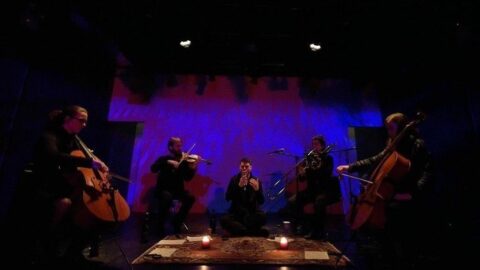“Please take a blanket; the heating will be turned off during the performance.” Closing the sixth annual Avant Music Festival on Saturday, March 7, 2015, Randy Gibson presented Apparitions of The Four Pillars in The Midwinter Starfield under The Astral 789 Duet at the East Village’s eco-friendly theater Wild Project. Although the musicians performed for 234 multi-sensory minutes, each audience member’s experience was a different length: a powerful sine wave drone filled the venue, welcoming the audience and accompanying them all the way to their exit. In a way, Wild Project’s front doors were the true formal bookends of Apparitions of The Four Pillars….
This evening was the tenth in a growing family of discovery performances that Gibson uses to guide his other compositions. Each Four Pillars performance evolves from the unique discoveries of the last, allowing improvisation and subliminal guidelines to expose new functions of just intonation intervals and 7:8:9 harmony. Like the 2013 Avant Music Festival performance of Four Pillars, Apparitions… featured a sine wave drone that enveloped the audience. The works typically included delay structures and layers to explore musical density, but Gibson and his longtime instrumental collaborators chose to remove these elements from Apparitions… to allow for greater focus on the immediate intervallic relationships. Layers and delays would have impeded their collaboration toward simple harmony with the drone. Without them, the musicians created endlessly shimmering intervallic moments and better controlled the piece’s long-form motion.
The musicians appeared onstage a few minutes late, giving the audience time to take in their surroundings. Tibetan incense filled the air and video sculpture inspired by the Aurora borealis danced across the stage’s squat back wall; Kryssy Wright’s lighting shone on the audience seats with warm red and pink lights. The stage was clear except for a Turkish rug, two candles, and instrumental equipment. The sine drone, containing every pitch that would be used in the piece, drowned conversation.

The musicians filed silently onto the rug and sat in chairs half-circled around the candles. Gibson sat cross-legged in the center, with violinist Christopher Otto and cellist Meaghan Burke to his right and trombonist/vocalist Jen Baker and cellist Mariel Roberts to his left. All musicians sat without moving for some time, some with eyes closed, listening to the drone’s pitches. Burke’s initial bowing was inaudible, introducing only new visual movement. Eventually pitch slowly curled into the air, each note taking minutes like skinny molasses as every musician joined with pristine control. Gibson’s mentor, La Monte Young, says that “Tuning is a function of time … the degree of precision is proportional to the duration of the analysis,” and Apparitions of The Four Pillars… indeed gave both the audience and performers the luxury to consider each new interval.
Halfway through the first hour, the improvisations began to thicken as the musicians reintroduced motion, force, and dissonance. Sometimes an instrument obviously partnered with another– Gibson’s Raga singing and the trombone conversing back and forth– but the musicians mostly collaborated through concentrated listening and occasional eyebrow flicks. Attempting to have the group “nestle into the drone,” Gibson had hairline decisions to make on instrumental amplification. The instruments were sometimes drowned by the incessant power of the drone, and one struggled to hear the nuances of texture and pitch.
The house lighting dimmed into darkness, and the music moved into its second hour. Although Gibson described the work as pulling improvisation from the “fabric” of the drone, this performance also reversed the direction of motion and worked to weave every element of the performance back into the drone. Each musician layered musical components like sediment: quick trombone runs, forceful bowing, climbing violin pitch. The strings marked the piece’s halfway point by exploring pitches near the highest audible range and the house lights faded back in, pulling the audience alert as every instrument improvised in a thick frenzy. The musicians sustained this intensity until they tired– the cellists began to rest and massage their arms– and the piece slowly unwound. Each musician completed their improvisations in reverse order of entrance, but rather than finishing the piece with one solo cello, both cellists finished together in agreement. Gibson lit a stick of incense in the center of the group, underscoring harmony as focus, before the musicians left the stage without applause or reappearance.
The performance did what it promised, that is, patiently explored its immediate harmonic relationships while nestling into a greater arc of experience. It inadvertently created a second drone: the relationship between the performers and the audience. The piece asked a significant amount of work from the audience during this three-hour weaving process. The multiple media elements enhanced and supported this integration, but the effort droned on; the definition of “harmony” was expanded to include not only musical collaboration, but the choices of the audience as well.
Ultimately, Gibson’s goal is to invite audiences into transcendent, meditative experiences. While Apparitions of The Four Pillars… was its own unique, immersive offering, Gibson was also engaged in personal discovery work that extended beyond the audience’s immediate reference. He uses the Four Pillars family of works to clarify his musical language, but without the delay structures of previous performances, the audience reached harmony with Apparitions… more quickly and was ready to consider additional elements. Having been so carefully guided to this point, how does the audience relate to Gibson’s personal concentration and the active multi-media elements? Was the audience expected to submit to the static drone, or to explore their heightened awareness? As much as this performance presented “a major evolution” in Gibson’s work, it also presented a major evolution for his audience’s involvement. He successfully invited and supported the audience into a new experience of harmony and consideration, and his musical density expanded into spaciousness that pushed open his environment.
























